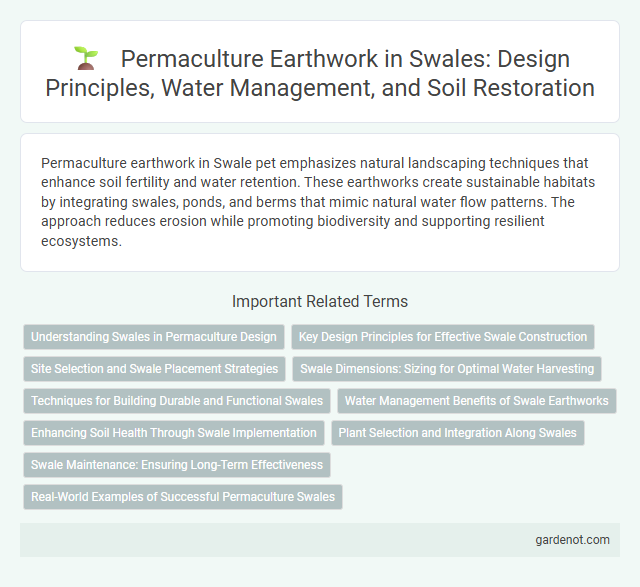Permaculture earthwork in Swale pet emphasizes natural landscaping techniques that enhance soil fertility and water retention. These earthworks create sustainable habitats by integrating swales, ponds, and berms that mimic natural water flow patterns. The approach reduces erosion while promoting biodiversity and supporting resilient ecosystems.
Understanding Swales in Permaculture Design
Swales are key earthworks in permaculture design that capture and slow rainwater runoff, allowing it to infiltrate the soil effectively. Constructed as shallow, contour-aligned ditches with adjacent berms, swales enhance soil moisture, reduce erosion, and support diverse plant growth by creating microclimates. Properly implemented swales improve water management in sustainable agriculture and landscape restoration, promoting resilience in various ecosystems.
Key Design Principles for Effective Swale Construction
Swale construction in permaculture relies on key design principles such as contour alignment to maximize water retention and prevent soil erosion. Proper sizing and spacing ensure optimal infiltration rates and groundwater recharge in various soil types and landscapes. Incorporating native vegetation stabilizes the swale banks and enhances biodiversity while improving overall ecosystem resilience.
Site Selection and Swale Placement Strategies
Effective swale placement in permaculture earthwork hinges on thorough site selection, prioritizing contour lines to maximize water capture and infiltration. Analyzing soil type, slope gradient, and existing vegetation patterns informs swale positioning for erosion control and soil moisture retention. Integrating swales with natural land features enhances groundwater recharge and promotes sustainable landscape resilience.
Swale Dimensions: Sizing for Optimal Water Harvesting
Swale dimensions are crucial for maximizing water retention and soil moisture in permaculture earthworks, typically designed with a width ranging from 1 to 3 meters and a depth between 0.3 to 0.6 meters depending on slope and soil permeability. Optimal swale sizing takes into account catchment area, rainfall intensity, and infiltration rates to ensure efficient water harvesting without causing erosion or overflow. Correctly sized swales promote effective groundwater recharge, improve plant growth, and contribute to sustainable landscape water management.
Techniques for Building Durable and Functional Swales
Techniques for building durable and functional swales in permaculture earthwork involve precise contour mapping to ensure effective water capture and infiltration. Utilizing berms composed of compacted soil alongside organic mulch layers stabilizes the structure while enhancing soil fertility and moisture retention. Incorporating keyline design principles and native deep-rooted vegetation further reinforces swale integrity and promotes ecosystem resilience.
Water Management Benefits of Swale Earthworks
Swale earthworks in permaculture enhance water management by capturing and infiltrating rainwater, reducing surface runoff and erosion while recharging groundwater supplies. Their design contours contour lines, enabling slow water absorption into the soil, promoting deeper root growth and improving landscape resilience during droughts. These swales create microclimates that support biodiversity and increase soil fertility through efficient nutrient retention and distribution.
Enhancing Soil Health Through Swale Implementation
Swale implementation in permaculture earthwork significantly enhances soil health by improving water retention and reducing erosion. Constructed as contour-based trenches, swales capture and slowly infiltrate rainfall, promoting deep soil hydration and supporting microbial activity. This natural irrigation method enriches organic matter and nutrient cycling, resulting in healthier, more productive soil ecosystems.
Plant Selection and Integration Along Swales
Selecting drought-tolerant native plants such as sedum, lavender, and native grasses enhances swale water retention and soil stabilization. Integrating nitrogen-fixing species like clover or lupine enriches soil fertility while deep-rooted plants improve subsurface water infiltration. Strategic layering of ground covers, shrubs, and trees along swales supports biodiversity and mimics natural ecosystems for sustainable permaculture earthwork.
Swale Maintenance: Ensuring Long-Term Effectiveness
Regular inspection and clearing of swale channels prevent sediment buildup and maintain optimal water flow. Vegetation management through planting deep-rooted native species stabilizes soil and reduces erosion along swale banks. Seasonal adjustments, such as reshaping berms and ensuring spillway integrity, enhance the swale's capacity to capture and infiltrate runoff efficiently over time.
Real-World Examples of Successful Permaculture Swales
Permaculture swales have been effectively implemented in arid regions like California's The Land Institute and Australia's South Australia's McHarg project, demonstrating significant improvements in soil moisture retention and erosion control. In Kenya's Loess Plateau, community-led swales revitalized degraded land, increasing agricultural productivity by up to 50%. These real-world examples highlight the critical role of contour-based earthworks in sustainable water management and regenerative agriculture.
Permaculture earthwork Infographic

 gardenot.com
gardenot.com